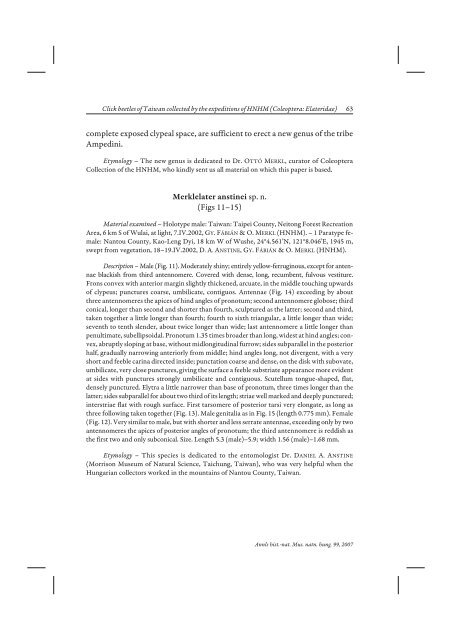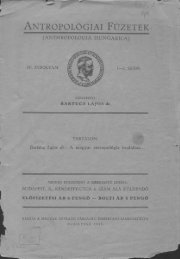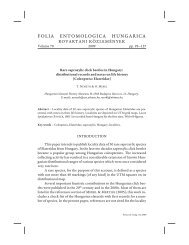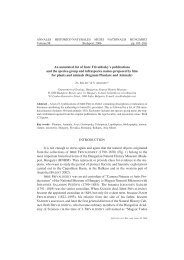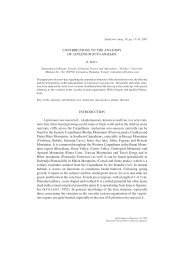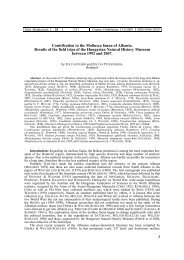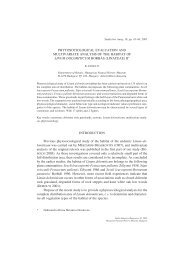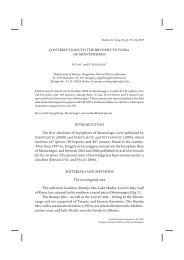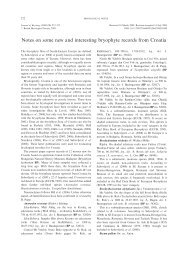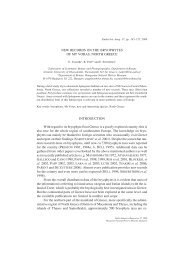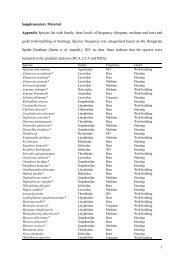Create successful ePaper yourself
Turn your PDF publications into a flip-book with our unique Google optimized e-Paper software.
Click beetles of Taiwan collected by the expeditions of HNHM (Coleoptera: Elateridae) 63complete exposed clypeal space, are sufficient to erect a new genus of the tribeAmped<strong>in</strong>i.Etymology – The new genus is dedicated to Dr. OTTÓ MERKL, curator of ColeopteraCollection of the HNHM, who k<strong>in</strong>dly sent us all material on which this paper is based.Merklelater anst<strong>in</strong>ei sp. n.(Figs 11–15)Material exam<strong>in</strong>ed – Holotype male: Taiwan: Taipei County, Neitong Forest RecreationArea, 6 km S of Wulai, at light, 7.IV.2002, GY.FÁBIÁN &O.MERKL (HNHM). – 1 Paratype female:Nantou County, Kao-Leng Dyi, 18 km W of Wushe, 24°4.561’N, 121°8.046’E, 1945 m,swept from vegetation, 18–19.IV.2002, D. A. ANSTINE, GY. FÁBIÁN & O. MERKL (HNHM).Description – Male (Fig. 11). Moderately sh<strong>in</strong>y; entirely yellow-ferrug<strong>in</strong>ous, except for antennaeblackish from third antennomere. Covered with dense, long, recumbent, fulvous vestiture.Frons convex with anterior marg<strong>in</strong> slightly thickened, arcuate, <strong>in</strong> the middle touch<strong>in</strong>g upwardsof clypeus; punctures coarse, umbilicate, contiguos. Antennae (Fig. 14) exceed<strong>in</strong>g by aboutthree antennomeres the apices of h<strong>in</strong>d angles of pronotum; second antennomere globose; thirdconical, longer than second and shorter than fourth, sculptured as the latter; second and third,taken together a little longer than fourth; fourth to sixth triangular, a little longer than wide;seventh to tenth slender, about twice longer than wide; last antennomere a little longer thanpenultimate, subellipsoidal. Pronotum 1.35 times broader than long, widest at h<strong>in</strong>d angles; convex,abruptly slop<strong>in</strong>g at base, without midlongitud<strong>in</strong>al furrow; sides subparallel <strong>in</strong> the posteriorhalf, gradually narrow<strong>in</strong>g anteriorly from middle; h<strong>in</strong>d angles long, not divergent, with a veryshort and feeble car<strong>in</strong>a directed <strong>in</strong>side; punctation coarse and dense, on the disk with subovate,umbilicate, very close punctures, giv<strong>in</strong>g the surface a feeble substriate appearance more evidentat sides with punctures strongly umbilicate and contiguous. Scutellum tongue-shaped, flat,densely punctured. Elytra a little narrower than base of pronotum, three times longer than thelatter; sides subparallel for about two third of its length; striae well marked and deeply punctured;<strong>in</strong>terstriae flat with rough surface. First tarsomere of posterior tarsi very elongate, as long asthree follow<strong>in</strong>g taken together (Fig. 13). Male genitalia as <strong>in</strong> Fig. 15 (length 0.775 mm). Female(Fig. 12). Very similar to male, but with shorter and less serrate antennae, exceed<strong>in</strong>g only by twoantennomeres the apices of posterior angles of pronotum; the third antennomere is reddish asthe first two and only subconical. Size. Length 5.3 (male)–5.9; width 1.56 (male)–1.68 mm.Etymology – This species is dedicated to the entomologist Dr. DANIEL A. ANSTINE(Morrison Museum of Natural Science, Taichung, Taiwan), who was very helpful when theHungarian collectors worked <strong>in</strong> the mounta<strong>in</strong>s of Nantou County, Taiwan.Annls hist.-nat. Mus. natn. hung. 99, 2007


